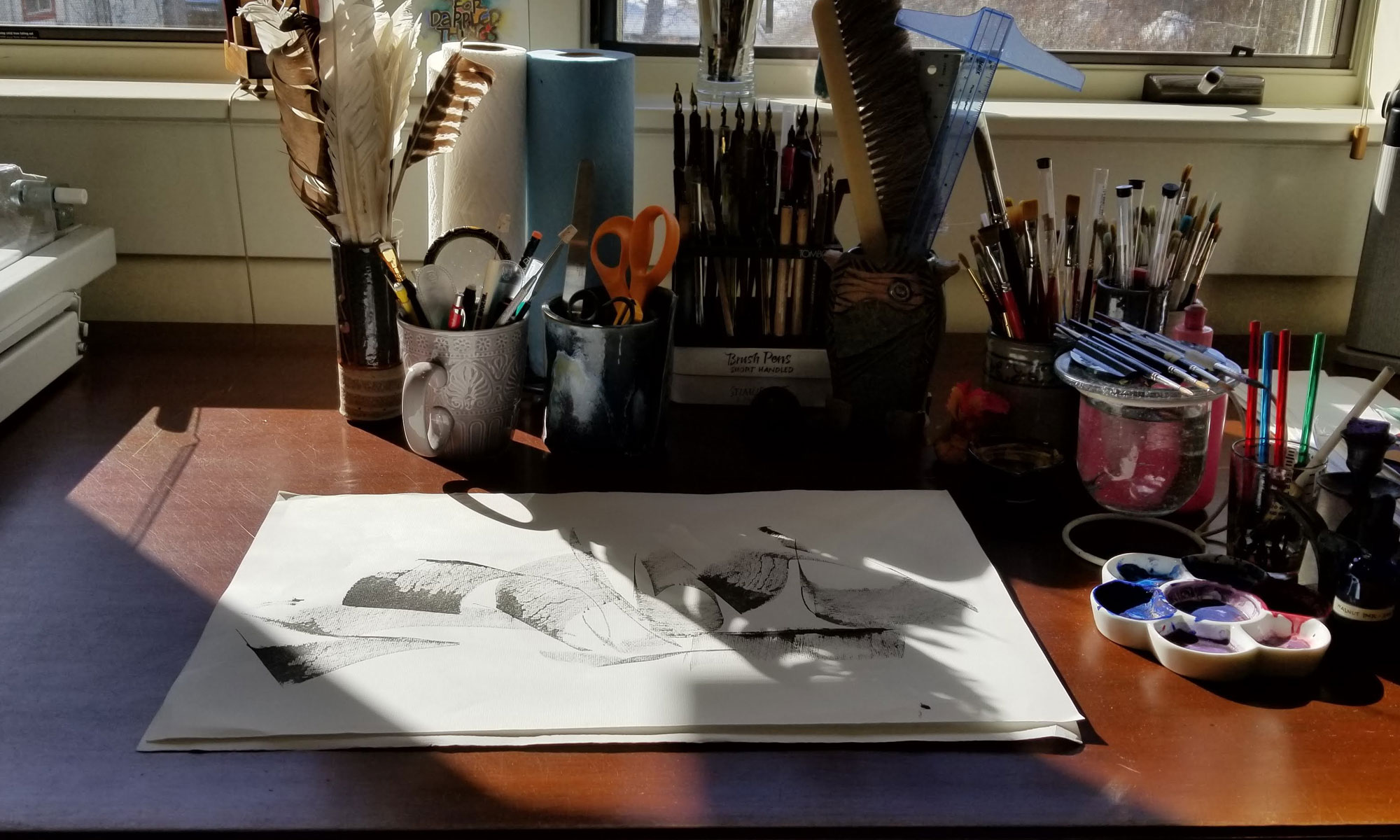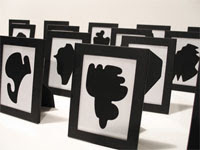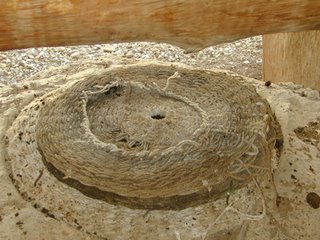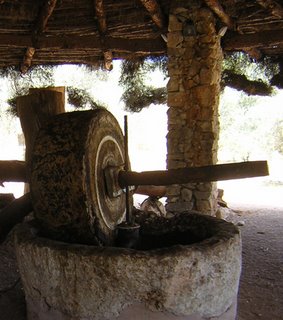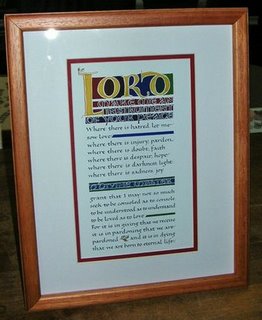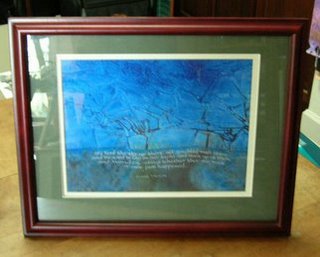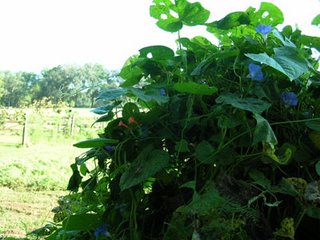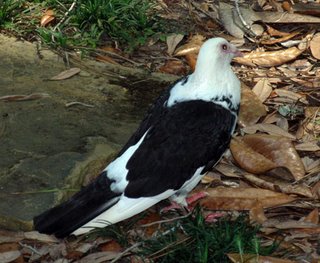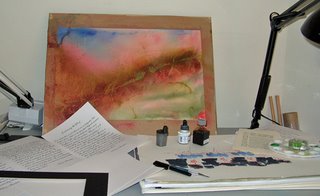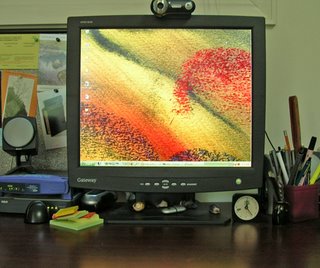I don’t have anything particularly calligraphic to relate, but I had a wonderful time in Manhattan this past weekend, and saw a lot of art.
Saturday morning we walked around Chelsea and looked in on a number of art galleries. I have a couple of pet peeves about New York art galleries. One of them is that some artists — or maybe gallery directors — have a reverence for space that is not shared by those of us who aren’t crowded into studio apartments. I appreciate space — really I do — but it seems as though some galleries have raised space itself to the rank of art, practically leaving the actual pieces of artwork to fend for themselves. I saw some of that this trip, but (paradoxically?) those galleries were … closed.
This show, “The Shapes Project“, at the Friedrich Petzel Gallery was fascinating, in an OC sort of way. Allan McCollum has created 300 shapes which combine in enough ways to produce a unique shape for every person on the planet. He has a developed a system to ensure that no shape will be accidentally repeated. The show mainly consists of row upon row of these black-and-white framed shapes, arranged in stadium-seating format and simply begging to be toppled, domino-style; also, notebook upon notebook upon notebook documenting the shapes that have been created so far. This man has so widened my understanding of the spectrum between whim and obsession that I’m thinking of going back and re-evaluating some projects I had abandoned simply because I thought them too complex or time-consuming.
My other peeve about art galleries concerns exhibits that consist entirely of pieces that are so self-referential as to be nothing more than confessionals or art therapy. I had the misfortune to stumble on one of those this trip. It was some sort of installation with random things on the walls and floors, irritating lighting that kept changing, and the most monotonous singing which tended to repeat lyrics way more times than their eloquence deserved.
Coming from the above-mentioned show, I was not in a good mood. So I was too ready to dismiss Robert Irwin’s installation, Who’s Afraid of Red, Yellow and Blue at Pace Wildenstein. I don’t know enough about modern art to say anything at all intelligent on the subject, so I probably ought to just shut up. But I won’t (more’s the pity). At first I thought this was a case of space-elevated-to-art. The huge warehouse of a room held only 3 foot-high, 15-foot square platforms painted in gloss red and blue and yellow, and aluminum panels suspended from the ceiling. That’s it. But the more I walked around it, the more I seemed to see the method in his madness. He had placed the yellow panel between the red and blue panels, I think because it had more tonal contrast. The suspended panels and the high-gloss paint on the platforms reflected colors back and forth, serving as a giant color wheel. Except the format of the color wheel was closer to the format of reflecting mirrors which reproduce images to infinity.
Or maybe it was all my head. That’s the niggling suspicion I usually experience when looking at modern/abstract art.
Saturday afternoon we saw the Broadway musical “Gray Gardens“. We hadn’t planned to see a musical this trip, but this was recommended and sounded interesting. Before attending the show, I couldn’t imagine how the plot could possibly lend itself to a musical. And I was of the same mind after attending the show. It was the strangest musical I have ever seen.
Saturday night we went to the Metropolitan Museum. The Vollard show was very interesting, as expected.

I didn’t expect the Tiffany exhibit to be spectacular, but it was. The exhibit recreated some garden architecture from whose eaves hung pane after pane of glass decorated with the wisteria design shown. What a breathtaking sight!
Sunday I visited The Cloisters for the first time. I had long wanted to visit this museum, which is a daughter of the Metropolitan Museum and dedicated to medieval art. The Cloisters itself is not to be missed. It’s one of the few places in the US where you could reasonably be confused into believing you’re in Europe — in Provence, maybe, or an Italian hill town. The walk up to the Cloisters is pleasant, and view at the top extends for miles. Many of the architectural details of The Cloisters were hauled over from Europe, including an entire 12th-century chapter room. In this museum I discovered that although I love medieval architecture — which is large-scale art — and manuscript books — which is small-scale art — I don’t care for much of the middle-scale artwork such as sculptures, painting, panels, and so on.
Looking back on the trip, I see that we packed a great deal into two days, and I enjoyed it even though I did without the attractions I rarely miss: The Morgan, SoHo, Talas, The Center for the Book Arts, Kremer Pigments, and a nice long walk from Chinatown to Times Square.
